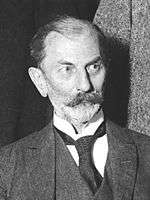Rudolf Havenstein
| Rudolf E. Havenstein | |
|---|---|
 | |
| Born |
10 March 1857 Meseritz, Prussia |
| Died |
20 November 1923 Berlin, Germany |
Rudolf E. A. Havenstein (10 March 1857 – 20 November 1923) was a German lawyer and president of the Reichsbank (German central bank) during the hyperinflation of 1921-1923.[1]
Havenstein was born in Meseritz (Międzyrzecz), Province of Posen. He came from a family of government officials and studied law in Heidelberg and Berlin. After graduation in 1876, Havenstein worked in the Prussian Justice service until 1887 when he began his career as a judge. In 1890 he moved to the Prussian Ministry of Finance. From 1900 to 1908, Havenstein was President of the Prussian State Bank. From 1908 to 1923, he was president of the Reichsbank and his signature appears on German Reichsbank notes from 1908 to 1923.
Havenstein was involved in the introduction of war bonds at the beginning of the First World War.
He died in Berlin and is buried in St. Anne's Cemetery in Berlin-Dahlem.
See also
References
- ↑ Shapiro, page 214.
- Adam Fergusson, When Money Dies: The Nightmare of Hyperinflation in Weimar Germany, Kimbler, 1975, republished 2010 by PublicAffairs, New York, ISBN 978-1-58648-994-6, Chapter 11 "Havenstein"
- Ahamed, Liaquat, Lords of Finance: The Bankers Who Broke the World, Penguin Books, 2009. ISBN 978-1-59420-182-0
- Bresciani-Turroni, The Economics of Inflation, pages 63, 156, 180, John Dickens Co Ltd, Northampton, 1931. http://mises.org/books/economicsofinflation.pdf
- Max Shapiro, The Penniless Billionaires, pages 213-214, New York Times Books, 1980, ISBN 0-8129-0923-2
| Government offices | ||
|---|---|---|
| Preceded by Richard Koch |
President of the German central bank 1908–1923 |
Succeeded by Hjalmar Schacht |